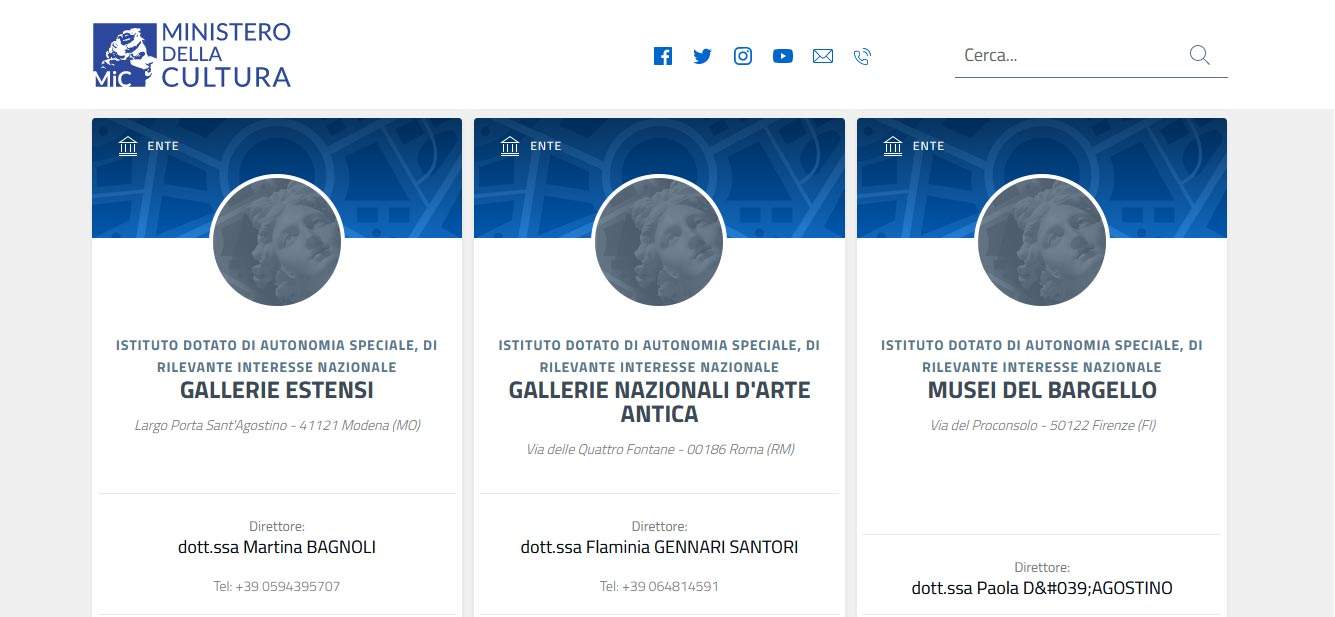Director or female director? For MiC, museum directors are always masculine
The controversy that arose following the words uttered during the Sanremo Festival by conductor Beatrice Venezi (who said that she preferred to be called by the masculine formula “conductor”) has also caused much discussion in the cultural heritage sector, given the presence of many female directors of museums, libraries, archives and, in general, women in top positions.
It is said that gender equality also passes through the use of the terminology that indicates the gender of the profession: but how does Italy’s top cultural institution, namely the Ministry of Culture, behave? It is easy to verify by scrolling through the MiC’s website: it seems that the Roman College still practices the use of the masculine inclusive neuter form (a custom that is, however, increasingly being questioned). This is at least on the main institutional pages, where the ministry’s organization is presented.
Thus, here are museums such as the Estensi Galleries, the National Galleries of Ancient Art, the Bargello Museums, the Royal Museums of Turin, the Girolamini Monumental Complex, and the Borghese Gallery(all directed by women), for the MiC have a “director” and not a “director.” The same is true for the directors of the Regional Secretariats, the Regional Museum Directorates, the Superintendencies, as well as the Undersecretary of State: even in this case, the position is declined in the masculine form despite the fact that the person holding it is a woman, Lucia Borgonzoni.
 |
| Beatrice Venezi |
Guidelines for gendered language?
MiC has not yet adopted guidelines for a gender language. Other ministries, however, have: this is the case, for example, with the Ministry of Education, University and Research, which on Women’s Day 2018 presented the “Guidelines for the Use of Gender in Administrative Language,” available in PDF format on the MIUR website. In the guidelines, the “neuter masculine” is referred to as a “really unfortunate definition”: “the grammatical neuter gender in Italian does not exist,” the guide explains, “and the grammatical masculine gender is, precisely, masculine, so in reference to human beings it evokes those of the male sex. The same document also calls for the need to ”use non-discriminatory language," a need that is, moreover, increasingly the subject of official acts. Accordingly, the guide argues, female gender nouns should be used when grammatically possible. Thus, one will say “the minister” if a woman holds the post, and not “the minister” or “the minister.”
“Gender assignment and agreement in Italian, as in other languages,” the guidelines explain, “do not occur according to random mechanisms or the free choice of the speaker, but are linked to rules (semantic and formal) of general scope that are acquired from early childhood. If these rules are not followed, misunderstandings or difficulties in understanding the text can be created because its structural compactness is weakened. And there is no linguistic reason to give names of professions and institutional roles different treatment.” As for plurals, since in Italian there is no inclusive ending for both genders, the guidelines suggest specifying both masculine and feminine: it is therefore preferable to avoid saying only “the directors.” Instead, it will be more appropriate to choose formulas such as “i direttori e le direttrici” or “the directors and the directors,” with the adjectives agreed in the masculine as Italian grammar requires (e.g., “the directors were awarded”).
Of course, one would argue that these rules are not always followed: at the moment, in fact, the Minister of University and Research, Maria Cristina Messa, is presented on the MIUR website as “minister Maria Cristina Messa.” While in the text presenting the guidelines, the minister who had promoted them, Valeria Fedeli, used the correct feminine form. That therefore, even the gender of a noun... depends on governments? More importantly, the question that should be asked is: why are there so many areas where the feminine cannot be serenely used?
 |
| Female directors of some museums on the MiC website |
 |
| Director or female director? For MiC, museum directors are always masculine |
Warning: the translation into English of the original Italian article was created using automatic tools. We undertake to review all articles, but we do not guarantee the total absence of inaccuracies in the translation due to the program. You can find the original by clicking on the ITA button. If you find any mistake,please contact us.





























